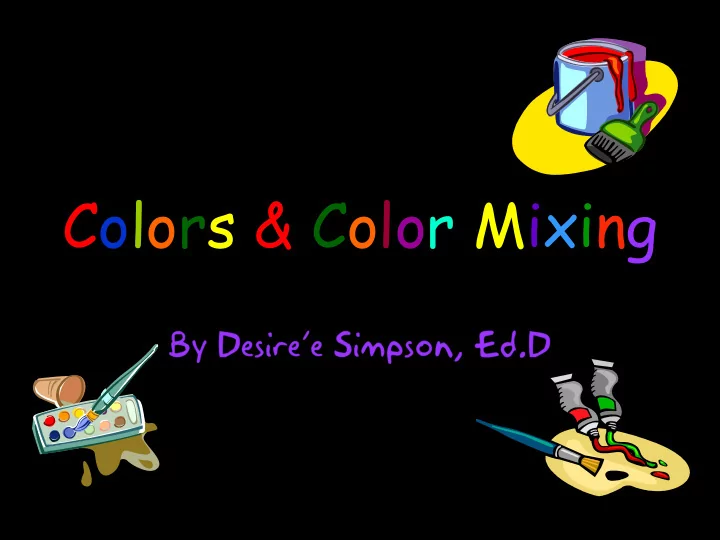

Colors & Color Mixing
Colors • Where do colors come from ? • What are the 3 basic color groups?
Colors come from. . . 2 substances found in nature ► Dyes & ► Pigments
more about colors Dyes come from plants, animals and insects. Their colors can be dissolved in water or other liquids, and are often used to color fabrics.
& more about colors Pigments are dry, powdery materials that have color. Some pigments come from natural sources in the earth like umber and sienna. ► Umber – a dark brown earthy color ► Sienna – a deep reddish-brown color
Colors Although all colors have their basic roots in nature, almost all are manufactured with a great deal of synthetic or man- made ingredients.
Colors Let’s look at three basic color groups: ► Primary colors (1 st group) ► Secondary colors (2 nd group) ► Tertiary colors (3 rd group)
Primary Colors: the first color group Red All other colors are made from these 3 colors. Yellow Blue
Secondary Colors: the second color group Secondary colors are: Violet Orange Green Violet Green Orange They are made by mixing primary colors together.
Le t’ s mix some colors Primary colors Secondary colors = + + = + =
Tertiary Colors ●
Tertiary colors Primary Secondary colors colors + = Red-orange + yellow-orange = yellow-green + = Tertiary colors + Blue-green = + Blue-violet = Red-violet + =
Mixing Tertiary Colors: the 3 rd color group • These colors are ▼ made by mixing ▼ ▼ ▼ ▼ primary and secondary colors together. ▼ • They are the colors between primary and secondary colors.
Color Mixing Remember. . . When you’re mixing colors, always start with the lightest color adding the darker color to it – to get the color you want . Color mixing does not work too well the other way around.
Color Mixing • Now that you know about colors and color mixing you are ready to create your own color wheel. • Remember, add darker colors to lighter colors. • Have fun!!!
Your Color Mixing Materials are. . .
Sources • Color wheels: http://www.colormatters.com/colortheory.ht ml • Colors wheels: http://www.sanford- artedventures.com/study/g_color_wheel.ht ml
Academic Standards • Students understand and apply elements and principles of design effectively in their work. • 6.8.1 Apply elements (line, shape, form, texture, color, value, and space) and principles (repetition, variety, rhythm, proportion, movement, balance, emphasis, and unity) in work that effectively communicates their ideas.
Academic Standards • 8.9.2 Demonstrate appropriate use of different media, techniques, and processes to communicate themes and ideas in their work including: • DRAWING: • Media: pencils, colored pencils, markers, ink, chalks, crayons, oil pastels, charcoals • PAINTING: • Media: tempera, watercolor, water-soluble oils, watercolor crayons; variety of surfaces, brushes and paint applicators • Processes: wet-on-wet, wet-on-dry, sponge, wash, resist, dry brush, watercolor techniques of sponging, salting, and masking
fin
Recommend
More recommend